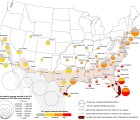
Introduction: An ongoing Zika virus pandemic in Latin America and the Caribbean has raised concerns that travel-related introduction of Zika virus could initiate local transmission in the United States (U.S.) by its primary vector, the mosquito Aedes aegypti.
Methods: We employed meteorologically driven models for 2006-2015 to simulate the potential seasonal abundance of adult Aedes aegypti for fifty cities within or near the margins of its known U.S. range. Mosquito abundance results were analyzed alongside travel and socioeconomic factors that are proxies of viral introduction and vulnerability to human-vector contact.
Results: Meteorological conditions are largely unsuitable for Aedes aegypti over the U.S. during winter months (December-March), except in southern Florida and south Texas where comparatively warm conditions can sustain low-to-moderate potential mosquito abundance. Meteorological conditions are suitable for Aedes aegypti across all fifty cities during peak summer months (July-September), though the mosquito has not been documented in all cities. Simulations indicate the highest mosquito abundance occurs in the Southeast and south Texas where locally acquired cases of Aedes-transmitted viruses have been reported previously. Cities in southern Florida and south Texas are at the nexus of high seasonal suitability for Aedes aegypti and strong potential for travel-related virus introduction. Higher poverty rates in cities along the U.S.-Mexico border may correlate with factors that increase human exposure to Aedes aegypti.
Discussion: Our results can inform baseline risk for local Zika virus transmission in the U.S. and the optimal timing of vector control activities, and underscore the need for enhanced surveillance for Aedes mosquitoes and Aedes-transmitted viruses.
